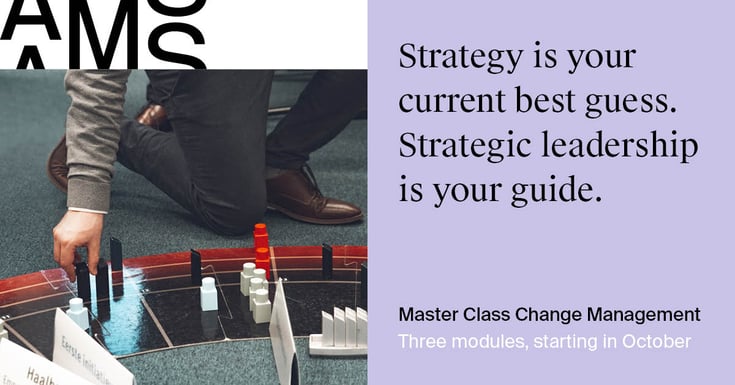Which steps do we need to go through to develop an effective strategy?
A strategy is a course of action followed by an organization to realize its purpose. In contrast to common use, strategy is not what an organization intends to do (its plan of action), but what it actually does (its pattern of action). Strategy is not a set of documents, but a set of deeds.
Strategy development is the process of adapting an organization’s course of action to best fit the environment in which it operates. In practice, this means that strategy development is about calling the current actions into question, determining a more appropriate set of actions, and getting people in the organization to carry out these actions.
Conceptual model
The Strategy Development Cycle describes how people in an organization need to go through four steps to adjust their actions. The model does not detail the typical analytical steps required to draw up a strategic plan, but rather the behavioral steps needed to provoke a change in people’s pattern of action. As such, the Strategy Development Cycle explains the journey that people in an organization jointly undertake to actually adapt what they do.
Typically, not all strategic issues will go through the cycle at the same time and speed. At any moment, there will be various topics in play in each of the four quadrants of the cycle.
Key elements
The four steps of the Strategy Development Cycle are the following:
- From Action to Awareness: Identification. As people in the organization are generally extremely busy running the existing business (exploitation), they tend to be less focused on scouting for new opportunities and threats (exploration). They know the existing situation, they have organizational routines in place, and they need to get tangible results. Potential future issues, on the other hand, are still rather vague, might require uncomfortable changes and might distract from current performance imperatives. But while it is not always appealing, it is essential to identify potential issues and create awareness in the organization that the current course of action might need to be adjusted.
- From Awareness to Agenda: Interpretation. With increased awareness of a wide range of opportunities and threats, the organization will need to select which topics are the most important and urgent to address. These priority issues will be the ones that need to be put at the top of the strategy agenda. Yet, in a VUCA environment, determining the importance and urgency of issues is a matter of interpretation, not calculation. Whether people think that threats will materialize and that opportunities are truly attractive, will depend on how they frame them and which interpretive lenses they use.
- From Agenda to Acceptance: Formulation. Once an issue makes it on to the strategy agenda, it is clear that changes will need to be made to the organization’s course of action, however disruptive that may be. In other words, a new set of actions will need to be formulated that is better suited to the issues as interpreted, but these adjustments will also need to be embraced by those who need to carry them out. This step of formulating a new strategy is often challenging because the internal changes required by the external demands are not always immediately acceptable to everyone in the organization.
- From Acceptance to Action: Implementation. With a widely supported new direction having been set, the last step is to actually adjust the organization’s course of action. Yet, even if people are willing to change, that does not mean they are always easily able to change or even have clarity on what to change. At the same time, while in the process of implementing the new course of action, the strategy development cycle can start again, as people establish that some of the new actions are not effective or have been made redundant by new developments of which they have become aware.
Key Insights
- Strategy development is about deeds, not documents. Many people think of strategy as a plan of action, which could be drawn up in PowerPoint by one person. But strategy is a course of action followed by a group of people. Therefore, strategy development is about getting people in the organization to adjust what they are doing to unfolding circumstances.
- Strategy development is a journey, not an event. Changing the organization’s course of action is not something that happens once a year. Course adjustments are based on four steps – identification, interpretation, formulation, and implementation – that should constantly be going on, with a variety of issues at various steps in the cycle.
- Strategy development is about people, not data. The strategy process is not an analytical journey that data goes on, but a behavioral journey that people go on – they need to become aware, set the agenda, accept adjustments, and implement new actions.
- Strategy development is subjective, not objective. In each of the four steps of the journey, people are challenged to let go of old certainties and explore new possibilities, to be creative and to get out of their comfort zone. None of this is straightforward or easy.
- Strategy development needs a guide, not a god. To help them through the strategy cycle, people do not need leaders who think they have all the answers and want to impose these. They need leaders who can guide them, by facilitating, challenging, and supporting them.





